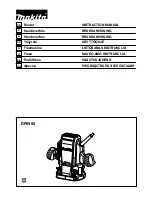
EN -10-
CHAPTER -4: FOOD STORAGE GUIDANCE
Refrigerator compartment
•
To reduce the humidity and consequently increase frost, never place liquids in unsealed containers in the
refrigerator. Frost tends to concentrate in the coldest parts of the evaporator and, in time, will require more
frequent defrosting.
•
Never place warm food in the refrigerator. Warm food should be allowed to cool at room temperature and should
be arranged to ensure adequate air circulation in the refrigerator compartment.
•
Nothing should touch the back wall as this will cause frost and the packages may stick to the back wall. Do not
open the refrigerator door too frequently.
• Arrange the meat and cleaned fish(wrapped in packages or sheets of plastic) which you will use in 1-2 days, in
the bottom section of the refrigerator compartment (that is above the crisper) as this is the coldest section and
will ensure the best storing conditions.
•
You can put fruits and vegetables into the crisper without packing.
Freezer compartment
•
Please use the deep freeze compartment of your refrigerator for storing frozen food for a long time and for
producing ice.
•
To get maximum capacity for the freezer compartment, please just use glass shelves for upper and middle
section. For the bottom section, please use lower basket.
•
Please do not place the food you that needs to be frozen next to the already frozen food.
• You should freeze the food to be frozen (meat, minced meat, fish, etc.) by dividing it into portions in such a way
that they can be consumed once.
•
Please do not refreeze the frozen food once it has already thawed. It may pose a danger to your health as it
may cause food poisoning.
•
Do not place the hot meals in your deep freeze before they become cold. You would cause the other food frozen
beforehand in the deep freeze to become putrefied.
•
When you buy frozen food, makes sure that they were frozen under appropriate conditions and that the
package is not torn.
•
While storing frozen food, the storage conditions on the package should certainly be observed. If there is no
additional information, the food must be consumed within the shortest time possible.
•
If the frozen food package was subject to humidity and has a foul smell, it might have been previously stored
under unsuitable conditions and gone rotten. Do not purchase this type of food!
•
The storage durations of frozen food change depending on the ambient temperature, the frequency of the
opening and closing of the doors, thermostat settings, food type and the time elapsed from the purchase time of
the food to the time it is placed into the freezer. Always follow the instructions on the package and never exceed
the indicated storage duration.
•
Please note: if you want to open the freezer door immediately after closing it, it will not open easily. This is a
normal occurrence. After reaching equilibrium condition, the door will open easily.
Important note:
•
Frozen foods, when thawed, should be cooked just as fresh foods. If they are not cooked after being thawed
they must NEVER be re-frozen.
•
The taste of some spices found in cooked dishes (anise, basil, watercress, vinegar, assorted spices, ginger,
garlic, onion, mustard, thyme, marjoram, black pepper, etc.) changes and they assume a stronger taste when
they are stored for a long period. Therefore, just a small amount of the spice should be added or the desired
spice should be added after the food has been thawed.
•
The food storage period is dependent on the oil used. Suitable oils include: margarine, half fat, olive oil and
butter and the unsuitable oils include: peanut oil and lard.
•
The food in liquid form should be frozen in plastic cups and other food should be frozen in plastic folios or bags.












































